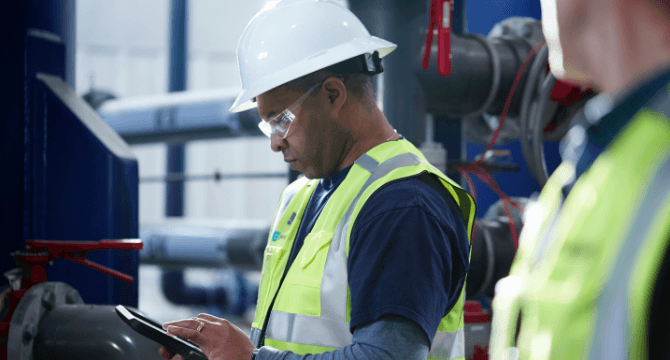5 Ways Artificial Intelligence (AI) Can Protect You, Your Wastewater, And Your Treatment Plant
Wastewater treatment plants, also known as Publicly Owned Treatment Works, are essential for protecting both the environment and our health. In the… read more
Apr 02, 2020
# of Minutes to Read

Wastewater treatment plants, also known as Publicly Owned Treatment Works, are essential for protecting both the environment and our health.
In the U.S. alone there are an estimated 14,748 Publicly Owned Treatment Works (POTWs) – each providing a wastewater collection, treatment, or disposal service.
These wastewater treatment plants (WWTPs) can vary in size, from a municipal wastewater plant treating the sewage for New York, to a small wastewater treatment facility that cleans the water coming from a factory.
Once wastewater enters a plant, and depending on what the city or town requires, it can go through three stages of treatment:
- Primary treatment: solids and sediment are removed from the water (and then sent to landfill or incinerated). About 60% of solids are eradicated.
- Secondary treatment: common biodegradable contaminants are lowered to safe levels. The wastewater is aerated and bacteria is used to consume nutrients and organic materials. About 90% of all solids and organic material are eradicated.
- Tertiary treatment: the quality of the water is raised to domestic and industrial standards. Chemicals are used to remove any remaining bacteria, viruses and microorganisms. The water can then be discharged back into the environment.
Wastewater treatment plants live and die by bacteria, and it’s the job of Plant Managers, Wastewater Directors and Wastewater Operators to maintain a healthy balance of it. ‘Good’ bacteria is needed to treat wastewater efficiently and safely, while ‘bad’ bacteria needs to be avoided as it could affect the running of the plant, and contaminate the environment if discharged.
But Managers and Operators have a problem…
If accidentally discharged from a treatment plant, contaminated water can have a devastating effect on fisheries, wildlife habitats, and our own health. This is why Plant Managers, Wastewater Directors, and Operators are so anxious to ensure their treatment operations are safe, efficient, and compliant.
That’s their challenge, and this is their problem: current testing methods of bacteria levels and types are expensive, resource-heavy, and time-consuming. They are often dependent on external testing partners and laboratories who can take a minimum of 5 days to return results. Not ideal when you think you have a problem.
The industry needs a better and simpler way to test the health of wastewater. And this is where new technologies such as artificial intelligence (AI) come in.
What is AI?
AI is the ability of a digital machine or program to perform tasks traditionally carried out by humans. And right now it’s filtering through a lot of our everyday lives, perhaps without you even thinking it’s AI.
Machine learning, a specific subset of AI, is particularly popular. It’s recommending what we should watch next on Netflix, blocking spam emails from our inbox, and automatically calculating our quickest route home from work.
While some applications are more trivial than others, all signs point towards AI becoming the new electricity. A technology that will usher in a fresh age of productivity and give almost every sector a boost.
But why now? The term AI has been around since the 1950s, however things have happened in the past decade to make potential AI techniques a practical reality. The first is an explosion of data. The second is the shift in computing power and storage.
The number of internet users has rocketed, while five years ago the population of mobile devices surpassed the population of humans! Meanwhile the advent of cloud computing, where data is stored on the internet rather than on a personal computer, has revolutionized data storage and opened up powerful IT systems to millions of users.
The result of all this is that AI has become more cost-effective and workable, giving rise to more use cases of the technology, from healthcare to wastewater treatment. AI is picking up the heavy lifting of repetitive, time-consuming tasks and, when it comes to protecting wastewater plants, is helping in a myriad of ways…

Five ways AI can protect wastewater treatment plants
1. AI identifies filament upsets to detect and avoid issues.
Filaments are bacteria and fungi that can be both positive and negative. Positively, they can add stability to the floc structure. Negatively, they can cause foaming and bulking.
When it comes to the wastewater treatment process, AI can address sludge expansion problems and help in improving aeration and pump efficiency. AI testing platforms, such as the one we’ve developed at opseyes, are trained on thousands of sludge images. This means they can spot issues with human-level accuracy, but at computer-level speeds.
2. AI predicts equipment failures with sensor data from motors.
By controlling the daily flow, and monitoring the systems and automation processes of a WWTP, AI can improve operational efficiency and reduce costs.
Machine learning algorithms are able to identify abnormal sensor behavior and so provide an early warning of asset degradation or failure. AI technology can also warn of leaks, bursts, and pollution incidents and – by monitoring areas such as the energy consumption of equipment – can predict when maintenance is required.
All of this allows Plant Managers, Wastewater Directors and Wastewater Operators to make much faster fact-based decisions.
3. AI predicts future effluent quality.
Effluent quality can provide a basis for a WWTP’s management decisions when it comes to minimizing microbial risks and optimizing operations.
However, monitoring effluent quality remains a big challenge for all WWTPs – especially at a time when more stringent wastewater effluent limits and regulations are being implemented.
Imagine if you could predict the effluent quality in real time? Gone would be the days of infrequent and inaccurate measurements, large operational costs and incorrect management decisions.
This is where creating a self-organizing fuzzy neural network (SOFNN) comes in. In short, a SOFNN has the ability to model and forecast a complex nonlinear system. A WWTP is one such system – subject to large disturbances in influent flow rate and pollutant load, as well as uncertainties over the makeup of incoming wastewater.
4. AI answers operator questions about procedures.
‘Grab sampling’ has commonly been used by wastewater operators to get some visibility over what’s going procedurally. However, this method requires ongoing labor and only provides a snapshot of conditions, not a real-time one.
Automating the sampling process with AI allows operators to identify patterns and trends. What’s more, a powerful AI testing platform can provide recommendations and analysis to managers in a plant, helping them understand what’s going on and what needs to be done. All without them having to slow or stop operations.
Plant Managers don’t have the hassle of sending samples to a lab or secondary location, while the sludges that are continually tested don’t change in composition as they no longer have to travel from plant to lab for processing.
5. AI finds previously hidden issues within large datasets.
Having data is one thing. Knowing how to use it is another.
Data scientists and experts can be expensive, and the required skill set to understand and process the data from a WWTP is rare.
This is a challenge for WWTPs which collect a relatively large amount of data with instruments from both influent and effluent streams. Enter AI.
AI applications can extract the data, process it, and make sense of it. The end result? Operational cost savings and predictive maintenance. This is crucial at a time when WWTPs face strict emission restrictions, and increased regulations around energy efficiency and resource recycling.
AI and the future of wastewater testing…
Plant Managers, Wastewater Directors and Wastewater Operators need a wastewater test which produces real-time, accurate, and actionable results in 10 minutes, not 10 days. That way Managers, and regulators, can understand exactly what’s going on inside their plant.
This is the test we’ve developed at opseyes.
With opseyes’ AI-powered testing platform, WWTPs can check the quality of their wastewater with just one photo, and get results in ten minutes. How?
- They place a sample of their activated sludge onto a microscope.
- They take a photo of the sludge with their phone and upload it to the opseyes platform.
- opseyes analyses the photo to identify key bacteria levels and types.
- The WWTP then receives a detailed Water Quality Report which reveals any issues and a personalized plan for what to do next.
Our patent-pending technology has been developed by Ramboll, the global sector specialists, and is based on years of experience and 1000s of data sets.
What’s more, we’ve co-developed our platform with water-testing expert Mr. Frank DeOrio, and trained our AI algorithms on thousands of sludge images, all to create a simpler way to test wastewater.
At the start of this new decade, it’s safe to say that AI is more fact than fiction. The technology can remove much of the heavy-lifting that is needed within a WWTP – freeing up time and resources to focus on other areas and stay compliant.
What to learn more about AI and protect your treatment plant? Get in touch today.